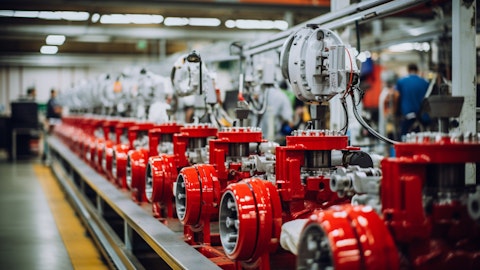So it’s not a new application for us. Renewables is another area that we’re seeing good investment playing in solar, where we are seeing meaningful business in solar as well as wind, particularly with our CUBIC acquisition. And then another area that is we think has bottomed and we’re seeing an impressive funnel building is in the area of warehouse automation and really the overall space of production logistics. And again, I’ll go back to the capabilities that we have that’s somewhat unique with AMRs, the mobile robots combined with the fixed automation that we’ve always had, we’re tracking some major projects there and we’ve had some wins and I talked about some of them on the call. But to give you an example of how those are playing out, there are a couple of customers that we’ve talked to in the last couple of months that have come off of discussions with labor, and have made it clear that they want to complement their people with technology to a greater extent over the next few years.
And those have resulted in multimillion dollar wins for Rockwell, as a result of moving more aggressively and adding technology to complement their scarce resources. And so those are the kinds of examples of mega projects that are starting to come in.
Joe Ritchie: And then and if I can maybe just make sure that I’ve got it totally squared for next year on the buckets of cost savings. So you mentioned $120 million for next year. We’re going to get something more on the structural side. And then incentive comp goes to 0 this year and so in a normal year, that would be like roughly basically about $120 million, $130 million headwind in a normal year. So is that just base lining it, is that the right way to think about it?
Nick Gangestad: Joe, you got it all right except for the last one. Our normal bonus expense is in the $160 million to $170 million range.
Operator: Our last question will come from Joe O’Dea from Wells Fargo.
Joe O’Dea: Blake, when you talk about packaging, delivering better order activity from Q3 to Q4, just want to level set on sort of what how that kind of sizes overall for the business. And so you talking food and beverage and household and personal care, and we should be thinking about 25% of revenue that would be seeing that pickup?
Blake Moret: Yes. Actually, so if you think about those verticals and that’s about the size of the overall verticals there. About 60% of our business in consumer packaged goods covered mainly by those 2 verticals is the OEMs, the machine builders. So that’s the way you could kind of do the calculus of how much of that business has been suppressed by the higher inventory levels and we’re expecting that to be dissipating over the coming quarters.
Joe O’Dea: And then the bridge on sort of prior guide to revised guide and the $3.75 sort of EPS impact on core. It looks like that could be something like a 60% to 70% decremental. And if that’s the case and we think about the flip side, do you think about sort of a reversal of these headwinds is translating to better incrementals than what you would traditionally think about, sort of through a cycle absent some of the temporary structural cost actions that are underway?
Nick Gangestad: Yes. When you strip out things like incentive compensation and what we’re showing there from investment spend, because those things would normally be part of what we talk about in terms of our incrementals and decrementals, but we stripped out those two details to give you more detail of the underlying moving parts in there. But there are many parts of our portfolio where incrementals and decrementals like that in that 60% range are certainly normal. They’re normally offset by some degree of incentive compensation or investment spend though.
Blake Moret: Yes. I think but directionally, I think you’re right in that Logix, we’ve seen the biggest correction based on the really tough comps with the huge growth from last year. And as that comes back in, that hardware does have high incrementals and high decrementals. We’ll put a lot around it with annual recurring revenue and so on, which does help us and continues to grow. But there’s no getting around that Logix is very profitable. We have high incrementals and high decrementals there.
Aijana Zellner: Thank you, everyone, for joining us today. That concludes today’s conference call.
Operator: At this time, you may now disconnect. Thank you.
Follow Rockwell Automation Inc (NYSE:ROK)
Follow Rockwell Automation Inc (NYSE:ROK)
Receive real-time insider trading and news alerts





